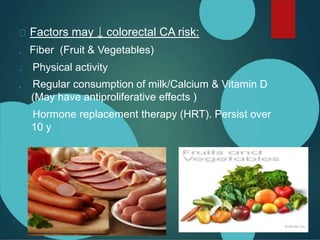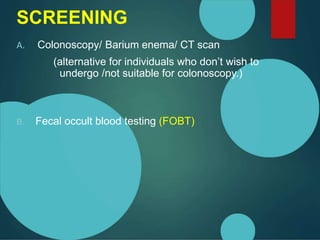colon ca.pptx
- 1. Solid Tumors Yazan Momani Medical oncologist
- 2. Definition . Malignant growth of tumor that begins from the inner wall of the colon or rectum.
- 3. EPIDEMIOLOGY . The 3rd most common malignancy worldwide ( ≥ 1.2 million new cases annually). . The incidence is greatest among males (37.4 per 100,000 vs. 29.9 per 100,000) . 3 rd leading cause of cancer-related deaths in US. . Highest incidence rates in economically developed countries . Invasive CA of rectum occurs less frequently (<1/3 cases)
- 4. Age & Colorectal CA Relationship: An individual’s risk of developing cancer of the colon or rectum increases with advancing age. The likelihood of cancer diagnosis ↑ after 40 years of age and rising progressively after age 50. The median age at diagnosis is 69 years. < 20% of patients are less than 50 years of age at the time of diagnosis.
- 5. SURVIVAL : 5-year survival rate: Disease Stage 5- Year survival Early stages (localized/stage I, II) of colon Early stages rectal cancer. 91 % 88% 70% Regional disease/Stage III: Colon & rectal cancer after the tumor has spread regionally to adjacent LNs or tissues Metastatic disease ≤ 12%
- 6. Pathophysiology . The formation of colorectal CA is a multistep process. . Begins with an abnormal growth of tissue known as a polyp (precursors to the disease) originating from the innermost wall of the colon.
- 7. A stalked colon polyp The process of transformation from polyp to malignant disease takes years. Once transformation occurs, cancer begins to spread through the wall of colon/rectum. It can eventually invade blood, L.Ns, or other organs directly.
- 8. 95% are adenocarcinoma (glandular tissue). The disease can be prevented by removal of precancerous tissue.
- 9. Anatomy The large intestine consists of the cecum; the ascending, transverse, descending, and sigmoid colon; and the rectum Ascending colon (22% of colorectal carcinomas) Transverse colon (11% of colorectal carcinomas) Descending colon (6% of colorectal carcinomas) Sigmoid colon (55% of colorectal carcinomas) 4 major tissue layers, from the lumen outward, form the large intestine: The mucosa Submucosa Muscularis propria Serosa
- 11. 23
- 12. Aetiology Aetiology is complex, involving: . Patient- specific factors . Environmental factor . Genetic factors Genetic mutations associated with colorectal cancer: . APC mutation/loss (Tumour suppressor gene). . P53 mutation . COX-2 overexpression (growth factor signalling pathways) . K-RAS mutation 35%, BRAF mutation 5% (oncogenes)
- 13. Risk Factors Increase age: Age >50 (90% of patients) Male sex Family history. Personal history: (history of colon polyps; multiple adenomas or size ≥10 mm) IBD (Ulcerative colitis, Crohn’s disease): ↑ 5- to 10-fold Risk ↑ with increasing extent of bowel involvement & disease duration.
- 14. Risk Factors Environmental factors/ Lifestyle: . Physical inactivity & obesity . Diet: fatty food Red meats processed meats (hot dogs and some luncheon meats) low fibers . Alcohol (excessive) . SMOKING: Rectal > colon Dose relationship (pack/year) Duration
- 15. Particularly smoking in early life. As compared to never-smokers, the risks of colorectal cancer and mortality in smokers were 18% and 25% higher, respectively. Early tobacco use influence risk of cancer recurrence and mortality among colon cancer survivors.
- 16. Factors may ↓ colorectal CA risk: . Fiber (Fruit & Vegetables) . Physical activity . Regular consumption of milk/Calcium & Vitamin D (May have antiproliferative effects ) . Hormone replacement therapy (HRT). Persist over 10 y
- 17. NSAID (Celecoxib) and Aspirin Use: . Regular use (2 x wk), over 10-15 year. . Inhibition of COX-2 & free radical formation. . COX-2 overexpression is seen in pre-cancerous & cancerous lesions in the colon . COX-2 overexpression is associated with: Decreased colon CA cell apoptosis Increased production of angiogenesis-promoting factors.
- 18. Signs & Symptoms 1. Subtle & nonspecific (generalised symptoms) 2. Asymptomatic (early stage). 3. **Persistent/sudden change in bowel habits: (*Prolong constipation *or diarrhea. *pencil thin stool) 4. Bleeding from rectum or blood In stool. 5. Vague Cramping or abdominal pain/discomfort, bloating , N, V 2ndry obstruction, perforation, bleeding.
- 19. Signs and symptoms 6. Weakness and tiredness (advanced stage). 7. Iron-deficiency anemia. 8. Unintentional weight loss 9. Increased liver enzymes (sign of liver metastasis) (AST/ALT) 10. Jaundice in advanced disease.
- 20. DIAGNOSIS . Signs and symptoms . Entire Large bowel evaluation: Colonoscopy Double-Contrast Barium Enema CT Colonography (detect adenomas at least 6 mm). Flexible sigmoidoscopy (FSIG) : examine lower half of the bowel to the splenic flexure, capable to detect 50%-60% of CA.
- 21. . Biopsy (during colonoscopy) . Ultrasound: Determines depth of tumor penetration, assessing L.Ns . CT scan: same as ultrasound + useful in assessing for metastasis . Blood tests: bld count, PT, PTT, Liver function test. . CEA (carcinoembryonic antigen) Tumour marker Non-sensitive, non specific in early stage Usually elevated in metastatic or recurrent colon CA Normal 0-3 ng/mL Monitor the recurrence.
- 22. SCREENING A. Colonoscopy/ Barium enema/ CT scan (alternative for individuals who don’t wish to undergo /not suitable for colonoscopy.) B. Fecal occult blood testing (FOBT)
- 23. 2. Fecal immunochemical test (FIT) Can be used to replace FOBT Sensitivity 60-85% Specificity > 97% No drug or food interactions Uses ABs to detect globin protein Hg in stool D. Digital Rectal Exam (DRE): Can detect anorectal palpable mass
- 24. Screening guidelines for early detection of colorectal CA with the goal of cancer prevention: Risk Screening recommendation Average risk (R.F ≥ 50 ys) both M/F . Annual DRE and FOBT/FIT and one of the following: – Sigmoidoscopy every 5 years – CT colonography every 5 years – Colonoscopy every 10 years – Barium enema every 5 years Family History Begin screening at age of 35-40 years or 10 years younger from first-degree relative colorectal cancer diagnosis IBD Begin screening at 8–15 years after diagnosis FAP Begin screening at 10-12 years HNPCC Begin screening at age of 20–25 years or 10 years younger from 1st-degree relative colorectal CA diagnosis
- 25. Staging: TNM Staging System T – (tumor size), based on DEPTH (penetration) invasion into mucosa T1 – Tumour invades the submucosa T2 – Invades the muscularis propria T3 – Invade through the muscularis propria into subserosa T4 – Tumors invading or adhering other local organs/structures/segments/ surface of visceral peritoneum N – lymph node involvement N1 – 1-3 +ve L.N N2 – ≥ 4 or more +ve L.N M – distant metastasis M0 – no other organs involved M1 – distant metastases are present
- 27. Simplified Staging System Stage Stage I Tumors that either invade into or through the submucosa with NO (+) LN Stage II Tumors that invade through the muscularis propria or into local organs with NO (+) LN Stage III Stage IV Any T with nodal involvement (+) LN Tumor with nodal involvement and with distant metastasis (usually liver, followed by lungs, then bones) 25% of patients present with stage IV
- 28. 34
- 29. Treatment I. Surgery II. Radiation III. chemotherapy IV. Targeted molecular therapies. Treat Depend on the location & extent of disease. Prognosis depend on extent of tumour penetration/LNs involvement, Metastases. Goals: Curative therapy for localized CA Palliative therapy for metastatic CA.
- 30. Rectal CA is more difficult to resect with wide margins. Local recurrence of rectal CA is more common compared to colon CA If lies closer to the anal sphincter, so the risk of localized treatment failure & recurrence at the initial site of disease is increased Radiation (XRT) is usually reserved for rectal cancer Adjuvant XRT + chemo. are standard for stage II/III rectal CA Neo- Adjuvant therapy before rectal surgery to: Shrink the tumour & make it resectable, prevent local recurrence in rectal CA.
- 31. In metastasis disease, radiotherapy will reduce the symptoms Stage I colon or rectal cancer are cured by surgical resection alone, adjuvant therapy is not indicated. Adjuvant chemotherapy in –ve L.N (stage II) colon cancer is controversial Adjuvant chemotherapy should be considered for stage II disease with pts. at higher risk for relapse : (inadequate LN sampling, bowel obstruction/ perforation of the bowel at presentation, poorly differentiated tumors, perineural invasion, and T lesions (stage IIB/IIC). 4
- 32. Adjuvant chemotherapy is standard therapy for patients with stage III colon cancer (decreases risk of cancer recurrence & death) Combined neo-adjuvant therapy + radiation therapy (chemoradiation) and surgery for patients with stage II or III rectal cancer is considered standard of care to decrease risk of local and distant disease recurrence.
- 33. Stage Stage I Management Surgery Stage II Stage III Stage IV Colon: Surgery (observation +/- chemo.) Rectal: Surgery + XRT + chemo. Colon: Surgery + Chemotherapy Rectal: Surgery + XRT + chemo. +/- surgery (selected pt.)+ chemo. + MoAB , Palliative care
































